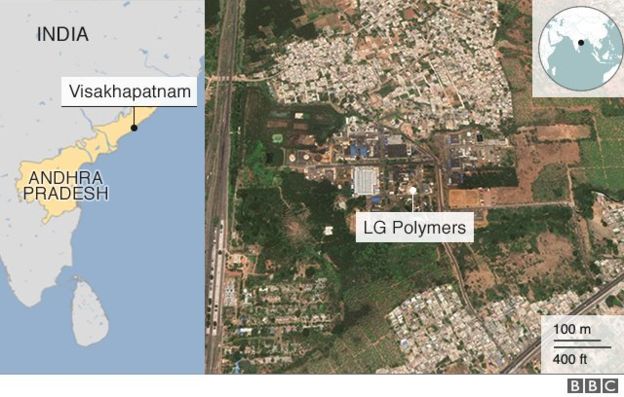Una de las consecuencias no deseadas de la inactividad en platas químicas y que requiere que las mismas tengan planes de contingencia para ocasiones en donde sus procesos se encuentran detenidos, es que los productos utilizados y almacenados in-situ pueden reaccionar, tanto por autodescomposición, por descomposición catalizada por otras sustancias, o por la presencia de otros reactivos. Esto puede inclusive suceder aun en tiempos que las plantas operan, pero en que los productos en cuestión permanecen en almacenamiento durante tiempos prolongados, como por ejemplo el linters de algodón, materia prima fundamental para la producción de propulsantes, que en determinadas condiciones de temperatura y humedad puede autoignitarse. En este caso una planta productora de polímeros en la India, perteneciente a la empresa LG, ha tenido un fuga de estireno de tanques que se encontraban inactivos debido a la cuarentena imperante. Hasta la fecha se habían producido 13 muertes y un número indeterminado de afectados de diversa gravedad, con escenas que recordaron el accidente del 3 de diciembre de 1984 en Bhopal, también en la India, considerado hasta hoy el más grave accidente de la industria química mundial. Allí otra planta inactiva, productora de pesticidas, propiedad de Union Carbide, tuvo una fuga de isocianato de metilo con un saldo de miles de muertos y decenas de miles de afectados.
At least 13 people have been killed by a massive gas leak at a chemical plant in southern India, with 800 others taken to hospital.
The leak from the LG Polymers plant in the city of Visakhapatnam in Andhra Pradesh state came as people slept.
Doctors say patients have been complaining of a burning sensation in the eyes and difficulties breathing.
Areas around the plant have been evacuated. The leak may have been due to negligence, officials say.
Reports suggest initial attempts to control the gas leak were unsuccessful but the company and state officials say the situation is now under control.
LG said in a statement it was investigating the cause of the incident, and was looking at ways “to provide speedy treatment” for those affected.
Rajendra Reddy, a senior official in the Andhra Pradesh Pollution Control Board, told the BBC that the leaked gas was styrene, which is usually refrigerated.
Prime Minister Narendra Modi called an emergency disaster meeting.
‘My eyes were itchy’
The leak took place at around 03:00 local time (21:30 GMT Wednesday) as the plant was being re-opened for the first time since 24 March, when India went into lockdown to curb the spread of coronavirus.
“All those who have been hospitalised are currently stable,” BK Naik, a local health official, told Reuters news agency. Doctors say 86 patients are being treated on ventilators, but many injured have been discharged.
Legal action is being taken against the company, says state Industries Minister Goutam Reddy. Earlier, he told BBC Telugu that it looked as though proper procedures and guidelines were not followed when the South Korean-owned plant was being re-opened.
“We would like the company to proactively respond to the incident and ensure that the same level of responsibility is taken if this incident were to happen in EU or United States,” he said, adding that the incident had been reported to the Korean embassy.
Swaroop Rani, a senior police official in Visakhapatnam, told AFP that the plant had been left idle because of the lockdown.
“[The gas] was left there because of the lockdown. It led to a chemical reaction and heat was produced inside the tanks, and the gas leaked because of that.”
Local villagers complained around 03:30 and police immediately went to the scene, but had to quickly retreat for fear of being poisoned, the news agency quoted her as saying.
“One could feel the gas in the air and it was not possible for any of us to stay there for more than a few minutes,” she said.

As the gas spread, residents ran out of their homes in panic. Distressing images of people fainting and dropping unconscious on the streets are being shared on social media.
“My eyes were itchy, and I was feeling drowsy, light-headed and slightly breathless,” Yashwanth Saikumar Ambati, who lives about 300 metres from the plant, told Reuters.
Officials said the fumes had spread over a radius of about 3km (2 miles) and people from surrounding areas were evacuated.
Although a large number have been admitted to hospital, most should be able to make a recovery, they added.
Fuente: https://www.bbc.com


